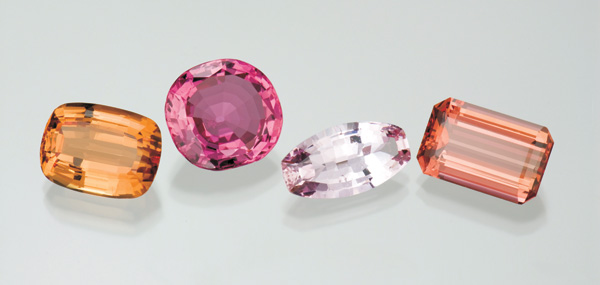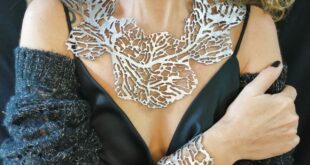Did You Know?
Many consumers know topaz simply as an inexpensive blue gem, but you might be surprised to learn its blue colour is rarely natural – it’s almost always colourless topaz that’s been treated to give it this blue colour.
You might also be surprised to learn that topaz comes in many more colours, including pinks and purples that rival the finest fancy sapphires. In fact, topaz has an exceptionally wide colour range that, besides brown, includes various tones and saturations of blue, green, yellow, orange, red, pink and purple.
Topaz is allochromatic, which means that its colour is caused by impurity elements or defects in its crystal structure rather than by an element of its basic chemical composition. The element chromium causes natural pink, red and violet-to-purple colours in topaz. Imperfections at the atomic level in a topaz crystal structure can cause yellow, brown and blue colour. Brown is a common topaz colour, and the gem is sometimes mistakenly called “smoky quartz.”
The colour varieties are often identified simply by hue name—blue topaz, pink topaz, and so forth—but there are also a couple of special trade names. Imperial topaz is medium reddish orange to orange-red. This is one of the gem’s most expensive colours.
History and Lore
Most authorities agree that the name topaz comes from Topazios, the old Greek name for a small island in the Red Sea, now called Zabargad. The island never produced topaz, but it was once a source of peridot, which was confused with topaz before the development of modern mineralogy. Some scholars trace the origin back to Sanskrit and the word topas or tapaz, meaning “fire.”
The ancient Greeks believed topaz gave them strength. Renaissance Europeans believed topaz could break magic spells and dispel anger. For centuries, many people in India have believed topaz worn above the heart assured long life, beauty and intelligence.
The 4Cs: Clarity, Colour, Cut and Carat Weight
Colour
Red is one of the most sought-after topaz colours and represents less than one-half of one percent of facet-grade material found. Medium reddish orange to orange-red topaz, which the trade calls imperial topaz, is highly prized and very rare.
Some say that pink topaz, often called rose topaz, resembles a pink diamond or a bright pink sapphire. Pink topaz has certain advantages over these two gems. It’s much less expensive than pink diamond, and it’s often available in larger sizes than either diamond or sapphire.
Dealers often use the trade term “sherry topaz” for yellowish brown or brownish yellow to orange topaz. Golden or yellow topaz lacks the prized red overtones of imperial topaz. It’s also much more abundant and therefore less valuable. Although brown topaz is also less valuable, it has been used in striking pieces of jewellery and ornamental art.
In nature, topaz is most commonly colourless, and naturally strong blue gems are extremely rare. In the marketplace, however, strong blue shades are plentiful because colourless topaz is treated with a combination of radiation and heat.
A fashioned topaz that displays a combination of two colours is called bicolour topaz. The most valued topaz colours are orangy red to red. Blue gems are widely available.
Clarity
Fashioned topaz gems are often free of visible inclusions or flaws.This is especially true of blue, colourless and yellow topaz.Other more rare colours like imperial and pink may show inclusions more often and still be valuable due to the colour’s rarity.
Cut
Because topaz crystals are usually elongated or columnar, they’re often cut as long oval or pear shapes to improve yield. If the rough is strongly coloured, the cutter often chooses the emerald cut because that cutting style maximizes colour and retains the most weight.
Carat Weight
Topaz can often form as large crystals that can yield sizeable cut gems.
Special Notes
Topaz is pleochroic, often displaying different colours in different crystal directions.
How to Care for Topaz
Topaz, which is an eight on the Mohs scale of mineral hardness, requires special care during cutting, polishing and mounting. Because it is not very tough, a hard blow might split it, and extreme pressure or sharp temperature changes might cause it to break. Jewellers prefer to set valuable topaz gems in protective mountings or use it in pieces that aren’t exposed to too much wear, like pendants and pins.
The gem’s colour is generally stable to light, but prolonged exposure to heat or sunlight might cause fading in yellow-to-brown, reddish brown or dark brown topaz. Topaz is only slightly affected by chemicals.
It’s important to avoid steam or ultrasound when cleaning topaz. Warm, soapy water works best.
Are you ready to learn more?
Consider taking a GIA course to gain a deeper understanding of ruby and the full spectrum of coloured gemstones. GIA offers several coloured gemstone courses that you can take online from the comfort of your home or through regular classes conducted by the Institute in Bahrain, Kuwait, Qatar, Saudi Arabia, Turkey, UAE and other important locations in the Gulf Region.
To learn more about GIA’s laboratory services and training programmes available in the Middle East, e-mail labme@gia.edu or edume@gia.edu or visit www.giamideast.com
 Collection Pan Arab Luxury Magazine
Collection Pan Arab Luxury Magazine






